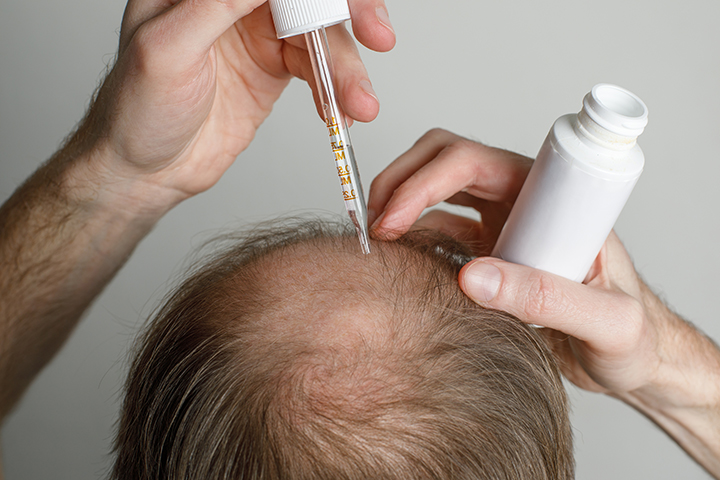Is Minoxidil Dangerous for my Pets?
 Recently, one of our pet parents shared with us that their husband was considering trying minoxidil to help prevent hair loss. Their dermatologist was wise and asked if they had pets- as minoxidil can be harmful- even fatal to cats and dogs- even in small doses.
Recently, one of our pet parents shared with us that their husband was considering trying minoxidil to help prevent hair loss. Their dermatologist was wise and asked if they had pets- as minoxidil can be harmful- even fatal to cats and dogs- even in small doses.
Minoxidil has not always been solely used for hair loss. In the 1970’s, it was actually developed as a drug to treat high blood pressure. Patients taking the medication in high doses noted hair growth as a side effect. The FDA approved Rogaine (active ingredient- minoxidil) in 1988 in men and 1992 for women. Today, there are dozens of hair restoration products that include minoxidil.
Minoxidil has become a staple for those struggling with hair loss. While its benefits for humans are well-documented, many pet owners are unaware of the serious risks it poses to their furry companions. If you use this medication and have pets at home, it’s crucial to understand the dangers, take necessary precautions, and recognize the signs of toxicity.
Why Minoxidil is Dangerous for Pets
Unlike humans, pets—particularly cats and dogs—lack the ability to properly metabolize and excrete minoxidil. Their bodies cannot synthesize enzymes to break down the drug efficiently, leading to rapid toxicity even in small amounts. This makes even indirect exposure, such as licking a minoxidil-contaminated surface or coming into contact with treated skin, extremely hazardous.
Minoxidil poisoning in pets primarily affects the cardiovascular system, causing symptoms like severe hypotension (low blood pressure), heart failure, and fluid accumulation in the lungs. These effects can develop quickly and may be fatal without immediate veterinary intervention.
Signs of Minoxidil Toxicity in Pets
If your pet has been exposed to minoxidil, they may exhibit the following symptoms:
- Lethargy or weakness
- Difficulty breathing
- Rapid or irregular heart rate
- Vomiting
- Drooling excessively
- Loss of coordination or collapse
- Bluish or pale gums (a sign of poor oxygen circulation)

- Swelling in the limbs or abdomen (due to fluid accumulation)
If you observe any of these symptoms, assume your pet has been poisoned and seek veterinary assistance immediately.
How Pets Get Exposed to Minoxidil
Minoxidil exposure in pets commonly occurs in the following ways:
- Direct contact with skin or fur: Pets that lick or nuzzle areas where minoxidil has been applied can ingest the substance.
- Contact with contaminated surfaces: If minoxidil is spilled on floors, furniture, or bedding, pets may come into contact with it and later ingest it through grooming.
- Ingestion of discarded product: Pets may chew on used bottles, applicators, or cotton swabs that contain residual amounts of the drug.
Precautions to Protect Your Pets
To keep your pets safe from minoxidil exposure, follow these precautions:
- Apply minoxidil in a pet-free area: Use the medication in a bathroom or enclosed space away from your pets.
- Allow full absorption before pet interaction: Minoxidil should dry completely before touching your pet to prevent transfer onto their fur or skin.
- Wash hands thoroughly after application: Always clean your hands before handling your pet to avoid accidental transfer.
- Store minoxidil securely: Keep bottles, applicators, and any materials that come into contact with the drug in a locked cabinet or high shelf out of reach.
- Clean spills immediately: If you spill minoxidil, wipe it up with disposable towels and clean the area with soap and water.
- Dispose of used materials properly: Cotton swabs, tissues, or other materials that have absorbed minoxidil should be discarded in a sealed trash can inaccessible to pets.
What to Do If Your Pet is Exposed to Minoxidil
If you suspect your pet has come into contact with minoxidil, take the following steps immediately:
- Remove any contaminated material: If the exposure was through skin contact, gently wipe or rinse the affected area with warm water.
- Do not induce vomiting: Unless instructed by a veterinarian, do not attempt to make your pet vomit, as this can worsen their condition.
- Monitor for symptoms: Keep a close eye on your pet for any signs of toxicity.
- Seek emergency veterinary care: Call your veterinarian or an emergency pet poison hotline, such as the ASPCA Animal Poison Control Center at (888) 426-4435, for immediate guidance.
Final Thoughts
Minoxidil can be a life-changing treatment for hair loss, but for pet owners, it carries serious risks. By taking proper precautions and understanding the dangers, you can keep your beloved pets safe while using this medication. Always treat minoxidil with the same level of caution as any other household toxin and never underestimate how even minor exposure can harm your furry friends. If an accident occurs, acting quickly can make all the difference in saving your pet’s life.
